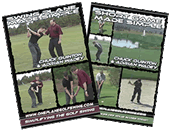by Chuck Quinton
How to Practice |
Rotary Swing Golf |
|
How to Practice
It's a strange thing to consider, when you think about it. It seemingly has a simple answer, but the truth is 99% of golfers at large either have no idea how
to practice or what to practice. If they do know, then they either ignore it from a lack of discipline, or more likely, get pulled in so many different
directions that they lose their way. Let's explore that one a bit further... So, what happened during the fella's practice session mentioned above? With all that diligent practice, shouldn't he score really well, I mean, he just worked on all the tools he needed for that first hole, right? Not necessarily. Working on that many things in a practice session and then trying to carry it over into a round of golf is a guaranteed way to set yourself up for failure. It's impossible for anyone to effectively work on new techniques, feelings, thoughts, etc. and then remember every little nuance out on the course while trying to score. Your mind and body need time to become comfortable with each piece, each subtle little detail in order to turn control over to the very proficient subconscious mind, but this doesn't happen in one practice session. From this point forward, you must make a commitment to yourself to work on the things I discuss below if you really want to impact significant improvement in your game.
Compartmentalization Let me explain to you how we practice when I'm working with one of my tour professionals. During the first few minutes of any practice session, we identify exactly what it is that we're going to work on for the day. We prioritize things by one simple rule: What is costing the most strokes? Is it the driver, putting, chipping? Once we have discussed the issue, we pick one thing, possibly two and generally keep it within the same aspect of the game. For instance, if the driver is the problem, we focus all our energy on that one club and will leave putting for another day. Why? Because any golfer's game is always in flux and we need as many things constant as possible to fall back on. Things always feel a touch different here or there, muscles get stiff, some get loose; but day in and day out things are never exactly the same. Keeping things constant allows us to fully transfer our work from the range to the course with minimal distraction; there is only one thing to focus on and it gets our utmost concentration. This is critically important. If your putting needs some work but the driver is what we are focusing on today, we don't want to have two things feel different and possibly uncomfortable because that chips away at our foundation and sureness about our game. It doesn't matter if your foundation has missing bricks, you know how it feels and performs and you can rely on it, and more importantly, it keeps your mind clear. We call this "Compartmentalizing". If the putter is really causing us fits but the driver got the top priority, we don't get concerned if we aren't making putts that day. We just file that away in the "Putter Compartment" and will revisit it another day. Today is the driver, nothing else will get a different swing thought, a different feel, a different setup; the driver receives 100% of our effort and mental focus. This, in turn, takes pressure and focus off other parts of your game that may not be working as well as you would like and helps ensure that we meet our goals for the practice session that we established at the beginning of practice.
When you try and change one thing in your chipping, a couple tweaks to your putting, one swing thought with your wedges, three
bunker thoughts and two driver changes you will end up getting "Maytag'd". What is "Maytag'd"? Have you ever seen a skiier or snowboarder cruising down the
mountain, catch an edge and then tumble down, end over end for the next 50 yards? That's being "Maytag'd", being tumbled end over end, out of control, just
like being in a washing machine. Having nothing to fall back on that is comfortable, even if incorrect and even if you know you must change it, is setting
yourself up to be "Maytag'd". |
|||
|
|
|
|
|
|



